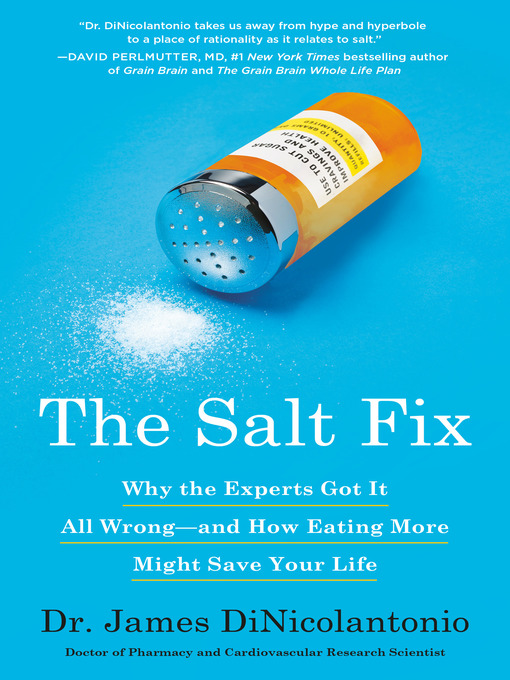- All Fiction
- Military Fiction
- Historical Fiction
- Mystery & Thriller
- Romance
- See all fiction collections
The Salt Fix
Why the Experts Got It All Wrong—and How Eating More Might Save Your Life
We’ve all heard the recommendation: eat no more than a teaspoon of salt a day for a healthy heart. Health-conscious Americans have hewn to the conventional wisdom that your salt shaker can put you on the fast track to a heart attack, and have suffered through bland but “heart-healthy” dinners as a result.
What if the low-salt dogma is wrong?
Dr. James DiNicolantonio has reviewed more than five hundred publications to unravel the impact of salt on blood pressure and heart disease. He’s reached a startling conclusion: The vast majority of us don’t need to watch our salt intake. In fact, for most of us, more salt would be advantageous to our nutrition—especially for those of us on the keto diet, as keto depletes this important mineral from our bodies. The Salt Fix tells the remarkable story of how salt became unfairly demonized—a never-before-told drama of competing egos and interests—and took the fall for another white crystal: sugar.
According to The Salt Fix, too little salt can:
• Make you crave sugar and refined carbs
• Send the body into semistarvation mode
• Lead to weight gain, insulin resistance, type 2 diabetes, cardiovascular disease, chronic kidney disease, and increased blood pressure and heart rate
But eating the salt you desire can improve everything, from your sleep, energy, and mental focus to your fitness, fertility, and sexual performance. It can even stave off common chronic illnesses, including heart disease.
The Salt Fix shows the best ways to add salt back into your diet, offering his transformative five-step program for recalibrating your salt thermostat to achieve your unique, ideal salt intake. Science has moved on from the low-salt dogma, and so should you—your life may depend on it.
-
Creators
-
Publisher
-
Release date
June 6, 2017 -
Formats
-
Kindle Book
-
OverDrive Read
- ISBN: 9780451496973
- File size: 8633 KB
-
EPUB ebook
- ISBN: 9780451496973
- File size: 8847 KB
-
-
Languages
- English
-
Reviews
-
Publisher's Weekly
June 19, 2017
DiNicolantonio, a cardiovascular research scientist and doctor of pharmacy, takes on the low-sodium mindset in this well-researched guide to better health. Citing our origins as creatures who “evolved from the briny sea,” DiNicolantonio posits that our bodies need salt to thrive, and need it in greater amounts than has been recommended by other medical authorities. Taking a look back through the last century to determine how the salt-as-enemy notion came about, he makes a fascinating case that the poorly researched and largely unfounded opinions of just a handful of people, in particular Dr. Walter Kempner, changed public health policy. DiNicolantonio goes on to link low-sodium diets to medical risks including obesity, heart failure, and kidney disease, before providing guidelines on how much salt humans should consume—in his view, 3 to 6 grams a day for healthy adults. His detailed text offers food for thought, backed with scientific research. -
Library Journal
May 15, 2017
For many years, medical practitioners have been telling people to limit their salt intake. Too much sodium adversely affects the heart and raises blood pressure. According to pharmacist and research scientist DiNicolantonio (Saint Luke's Mid America Heart Inst., MO), they are mistaken. The human body needs salt to function efficiently, and restricting consumption levels does not prevent heart disease. In fact, too little salt leads to eating too much sugar, resulting in diabetes, insulin resistance, and heart disease. The author supports his argument with plenty of evidence from the scientific literature. He also provides a great deal of information about the various types of salt, the amount that people need, diets for balancing salt and sugar use, and the salt content of popular foods. This title contains an extensive bibliography and time line covering the history of restrictive salt guidelines. The author also encourages readers to discuss their dietary needs with their health-care practitioners. VERDICT Thought-provoking, evidence-based information for anyone interested in improving their health.--Barbara Bibel, formerly Oakland P.L.
Copyright 2017 Library Journal, LLC Used with permission.
-
Formats
- Kindle Book
- OverDrive Read
- EPUB ebook
subjects
Languages
- English
Loading
Why is availability limited?
×Availability can change throughout the month based on the library's budget. You can still place a hold on the title, and your hold will be automatically filled as soon as the title is available again.
The Kindle Book format for this title is not supported on:
×Read-along ebook
×The OverDrive Read format of this ebook has professional narration that plays while you read in your browser. Learn more here.


